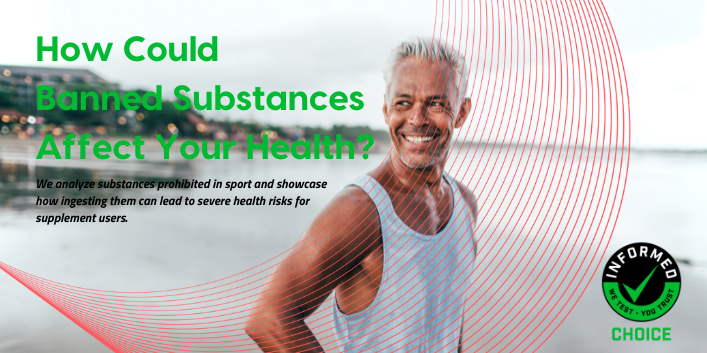Informed Choice News
Prohibited Substances and Your Health

How can a substance banned in sports affect someone who is not an elite athlete? Our research shows that nearly 1 in 10 dietary supplement products have traces of inadvertent contamination with banned substances. Even though most supplement users are not drug tested to the level of elite athletes, ingesting a banned substance has the potential to lead to severe health risks.
There are numerous banned substances available by prescription or can easily be found as ingredients in dietary supplements available for purchase. It’s vital for all supplement users to remember that just because a substance is banned by sport does not mean it’s banned for sale. Health risks increase for those who take prescription medications for a variety of health issues. Prior to including supplements in your regimen, it is recommended to consult a physician or dietitian.
The following are examples of prohibited substances that are commonly used for medical purposes or found as ingredients in sports nutrition supplement products:
Anabolic Agents
One of the more commonly known classes of banned substances, anabolic agents are medically used to treat hormonal issues and diseases that cause loss of muscle[i]. One compound that remains in the sporting news headlines is DHEA.
DHEA is found in supplements claiming to help with weight loss, depression, cervical cancer, sexual dysfunction, and lupus[ii]. Despite the wide range of medical uses, DHEA is still banned for use in sports. Those who live active lifestyles and are concerned with their health should take even more precautions because of this. Should a supplement user use a supplement that is produced in the same facility as a DHEA supplement, there is a risk for cross-contamination.
The ingesting of anabolic steroids can lead to a variety of severe health concerns, such as cardiovascular diseases like heart attacks and strokes, increased risk of blood clots, liver damage, and, in rare cases, a liver condition peliosis hepatis in which blood-filled cysts form[iii]. The following are a number of other side effects that can occur:
- Physiological:
- Acne
- Male patterned baldness
- Stunted growth
- Psychological:
- Increased aggressiveness, sometimes referred to as “roid rage”
- Impaired judgement
- Delusions
- Withdrawal has been associated with depression and suicide.
- Males:
- Shrinking of testicles
- Decreased sperm production
- Development of breast tissue
- Hair loss
- Females:
- Facial hair growth and/or excess body hair
- Decrease of breast size
- Abnormal menstrual cycles
- Deeping of voice
- Enlarged clitoris
Peptide Hormones. Growth Factors, Related Substances, and Mimetics
Peptide hormones are prescribed to treat a variety of illnesses and diseases. Synthetic peptides, such as Sermorelin and Ipamorelin, are marketed as assistants for anti-aging, muscle building, and fat loss[iv]. These attributes are why peptide hormones, growth factors, and other related substances are banned.
Possible side effects:
- Hypertension ((ESAs/hGH)
- Blood cancers/leukemia (ESAs/hGH)
- Anemia (ESAs)
- Stroke (ESAs)
- Heart attack
- Pulmonary embolism (ESAs)
- Feminization (hCG)
- Thyroid problems (hGH
Beta-2 Agonists
Beta-2 Agonists are a class of drugs used to treat asthmatic conditions and obstructive pulmonary disease. There are some inhaled beta-2 agonists, such as salbutamol and salmeterol, which are permitted up to certain dose limits. However, there are others that can still be found within sports supplement products, such as higenamine.
Higenamine is a chemical found in several plants such as aconite, Annona squamosa, Nandina domestica (sacred bamboo), and others[v]. It was banned by the World Anti-Doping Agency (WADA) in 2016. However, higenamine is still readily available in many pre-workout and weight-loss products[vi].
The possible side effects of taking beta-2 agonists are:
- Rapid heart rate
- Headaches
- Sweating
- Nausea
- Muscle cramps
- Nervousness
Beta-2 agonists can have interactions with certain medications (found below).
- Amisulpride
- Bepridil
- Cisapride
- Dronedarone
- Fluconazole
- Ketoconazole
- Mesoridazine
- Nelfinavir
- Pimozide
- Piperaquine
- Posaconazole
- Saquinavir
- Sparfloxacin
- Terfenadine
- Thioridazine
- Tranylcypromine
- Ziprasidone
Certain medical issues can be worsened after consuming beta-2 agonists:
- Seizures
- Parkinson’s disease
- Heart rhythm problems
- Type 2 diabetes
- Overactive thyroid[vii]
Hormone and Metabolic Modulators
An example of widely used Hormone and Metabolic Modulators is Selective Estrogen Receptor Modulators (SERMS). SERMS are used as a treatment for breast cancer, osteoporosis, and post-menopausal symptoms. There are also some benefits of SERMS being used to decrease the frequency of non-vertebral fractures in the elderly population[viii]. According to a study in 2003, SERMS have potential drug interactions with warfarin, rifampicin (rifampin), cholestyramine, and aromatase inhibitors[ix].
Possible side effects include:
- Dramatic change in blood sugar levels (Insulin)
- Endocrine system disruption (Clomiphene)
- Liver damage (AICAR)
- Cholesterol imbalance (Aromatase Inhibitors)
- Motor function disorders and tremors (Trimetazidine)
Diuretics and Masking Agents
All diuretics are considered to be masking agents by WADA and have been banned in sports since 1988. Diuretics are used to treat medical conditions such as heart failure, high blood pressure, kidney and liver problems, and glaucoma[x]. Unknowingly taking a diuretic can cause possible drug interactions with a variety of prescriptions. Dosages of insulin may even need to be adjusted[xi].
Side effects associated with diuretics include:
- Dehydration
- Muscle cramps
- Dizziness or fainting
- A drop in blood pressure
- Loss of coordination and balance.
Stimulants
Obviously, stimulants like cocaine are illegal both in sports and for sale. However, legal stimulants play an important role in treating a range of medical conditions. Prescription stimulants are widely used for ADHD and narcolepsy. Stimulants can prove dangerous for various medical conditions and prescription drugs. Some medical conditions include cardiovascular, glaucoma, hypertension, and numerous psychiatric disorders. Prescription stimulants have been found to have interactions with a wide variety of drugs, mostly those used to treat one of the before-mentioned medical conditions[xii].
Methylhexaneamine is a stimulant that can be easily found in many supplements used for weight loss, bodybuilding, and improving performance. Beware of what is on the ingredients list located on the product label. Many times, Methylhexaneamine is listed as rose geranium, geranium oil, or geranium stems[xiii]. It may even be used in a brand’s proprietary blend which means it won’t be clearly listed on the label. Most reputable certified supplement brands provide assurance to their customers by having their products tested and certified by a third-party supplement testing lab.
Possible side effects include:
- Insomnia
- Extreme weight loss
- Addiction
- Dehydration
- Tremors
- Increased heart rate
- Increased blood pressure
- Higher risk of stroke, heart attack and seizures
Narcotics
Narcotics are pain relievers that should only ever be used under a healthcare provider’s recommendation and prescription. The following narcotics are listed as banned in the latest WADA Prohibited List: Buprenorphine; Dextromoramide; Diamorphine (heroin); Fentanyl and its derivatives; Hydromorphone; Methadone; Morphine; Nicomorphine; Oxycodone; Oxymorphone; Pentazocine; Pethidine. Like other banned substance categories, narcotics have an effect on several medical issues and prescription drugs. Examples of such drugs include certain antidepressants, anti-seizure medications, medications for nerve pain, drugs used to treat psychiatric disorders, and more[xiv].
Possible side effects:
- Nausea and vomiting
- Higher pain threshold
- Decreased heart rate
- Dependence and possibly addiction
- Respiratory depression
- Death
Cannabinoids
According to WADA, all-natural and synthetic cannabinoids are prohibited, with the exception of Cannabidiol. Cannabidiol is commonly used for epilepsy. Despite claims that it is an effective treatment for a wide range of other diseases and illnesses, there isn’t scientific evidence to prove that. CBD products could contain levels of other cannabinoids banned by WADA or even traces of THC[xv]. For those drug-tested personnel, this could lead to a positive drug test.
Possible side effects:
- Increased heart rate
- Impaired short-term memory
- Distorted sense of time
- Diminished concentration
- Insatiability of mood
- Impairment of coordination and reflexes
- Reduced thinking and reading comprehension
- Respiratory diseases
Glucocorticoids
Glucocorticoids are widely prescribed for inflammatory and autoimmune diseases including multiple sclerosis, rheumatoid arthritis, ulcerative colitis, psoriasis, and eczema[xvi] According to WADA, “All glucocorticoids are prohibited when administered by oral, intravenous, intramuscular or rectal routes.” Glucocorticoids also interact with medications that affect the levels of potassium in blood and drugs resulting in decreased cortisone in the blood. Blood pressure and blood sugar can be increased after ingesting glucocorticoids[xvii].
Other potential health effects:
- Loss of muscle mass and bone density
- Decrease or stop growth
- Suppression of the immune system
As a supplement user, it is important for your health to know the ingredients in the supplements you’re taking. Even if a substance is prohibited by a sporting body, generally it is still widely available for medical purposes. In some cases, nutritional supplements can contain some form of a banned substance. Although you may not see the substance included on the ingredient list, the supplement could have been contaminated during the manufacturing process, supply chain, or by way of raw material. The importance increases if you currently have a medical condition, are pregnant, or are taking prescription medications since a banned substance can cause a drug interaction. Ensure your supplements are safer for use by only using supplements tested and certified by a third-party quality assurance program, like Informed Choice.
Informed Choice is a global retail monitoring and dietary supplement testing program that helps to reduce the risk of impurities and banned substances entering products. We test for over 220 banned substances. While no laboratory analysis will encompass all the analytes listed in WADA’s prohibited list, LGC is constantly developing new technologies and using our relationships with international anti-doping organizations in order to provide appropriate coverage for new and emerging threats.
Browse all products certified by Informed Choice.
Stay updated on the latest news in the dietary supplement industry by subscribing to our monthly newsletter!
Your information will not be shared with third parties. View our privacy policy
[i] National Institute on Drug Abuse. (n.d.). Anabolic Steroids. Retrieved from https://www.drugabuse.gov/publications/drugfacts/anabolic-steroids
[ii] Newman, T. (2018, June 14). Dehydroepiandrosterone (DHEA): Uses, side effects, and interactions. Retrieved from https://www.medicalnewstoday.com/articles/308684#risks
[iii] National Institute on Drug Abuse. (n.d.). What are the side effects of anabolic steroid misuse? Retrieved from https://www.drugabuse.gov/publications/research-reports/steroids-other-a...
[iv] Peptide hormones as ingredients in supplements. (n.d.). Retrieved from https://www.opss.org/article/peptide-hormones-ingredients-supplements
[v] Higenamine: Health Benefits, Uses, Side Effects, Dosage & Interactions. (2019, September 17). Retrieved from https://www.rxlist.com/higenamine/supplements.htm
[vi] Higenamine: What Athletes Need to Know to Compete Clean: USADA. (2020, January 3). Retrieved from https://www.usada.org/spirit-of-sport/education/higenamine-what-athletes...
[vii] Beta-2 adrenergic agonist Oral, Injection Advanced Patient Information. (n.d.). Retrieved from https://www.drugs.com/cons/beta-2-adrenergic-agonist-oral-injection.html
[viii] An, K.-C. (2016, August). Selective Estrogen Receptor Modulators. Retrieved from https://www.ncbi.nlm.nih.gov/pmc/articles/PMC4995266/
[ix] Morello, K. C., Wurz, G. T., & DeGregorio, M. W. (2003). Pharmacokinetics of selective estrogen receptor modulators. Retrieved from https://www.ncbi.nlm.nih.gov/pubmed/12648026
[x] Mischa. (2017, November 7). Drugs in sport. Retrieved from https://www.science.org.au/curious/people-medicine/drugs-sport
[xi] Diuretic - Warnings, Precautions, Side Effects & Interactions: Everyday Health. (2015, October 20). Retrieved from https://www.everydayhealth.com/diuretic/guide/
[xii] Adderall Drug Interactions. (n.d.). Retrieved from https://www.drugs.com/drug-interactions/amphetamine-dextroamphetamine,ad...
[xiii] Dimethylamylamine: Health Benefits, Uses, Side Effects, Dosage & Interactions. (2019, September 17). Retrieved from https://www.rxlist.com/dimethylamylamine/supplements.htm
[xiv] Dangerous drug interactions can occur with opioid medication. (2020, January 18). Retrieved from https://www.mayoclinic.org/diseases-conditions/prescription-drug-abuse/e...
[xv] Lachenmeier, D. W., & Diel, P. (2019, December 14). A Warning against the Negligent Use of Cannabidiol in Professional and Amateur Athletes. Retrieved from https://www.ncbi.nlm.nih.gov/pmc/articles/PMC6956040/
[xvi] Case-Lo, C. (2018, September 29). Glucocorticoids: List, Uses, Side Effects, and More. Retrieved from https://www.healthline.com/health/glucocorticoids#uses
[xvii] main drug interactions with corticosteroids. (2019, August 6). Retrieved from https://cortisone-info.com/en/general-information/drug-interactions/










